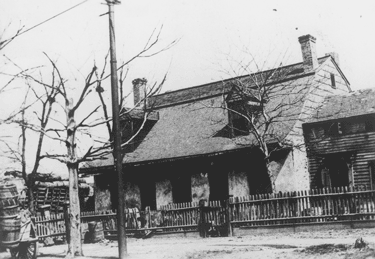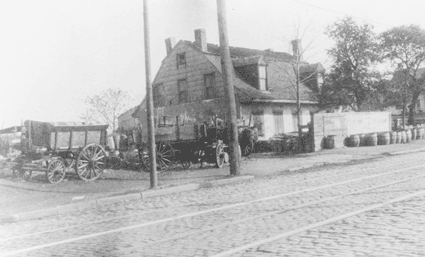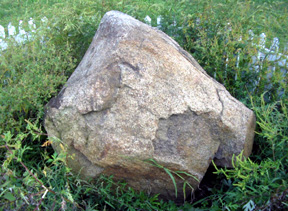VANDER ENDE-ONDERDONK House
or as known today
The ONDERDONK House

Located in Ridgewood on the border of Queens and Brooklyn, it is the oldest Dutch Colonial
stone house in New York City.
Peter STUYVESANT granted the land it sits on in the mid-seventeenth century, and by 1660,
Hendrick Barents SMIDT occupied a small house on the site.
The site was part of a land grant of 54 morgens (108 acres) issued by Peter STUYVESANT,
governor of New Netherlands, on December 15, 1654.
In 1709, Paulus VANDER ENDE of Flatbush, purchased the farm and began construction of
the current house. The building was a prominent marker in the 1769 settlement of the
boundary dispute between Bushwick in Kings County and Newtown in Queens County.
It is called the ONDERDONK House because on April 27, 1821, Adrian ONDERDONK purchased the
58-acre farm with the house and barn for $6,000. The farm extended south from Flushing Avenue
to what is now Catalpa Avenue. During the 1820's, Adrian ONDERDONK erected a small frame
addition to the stone house immediately above the remnants of the foundation of the 1660
building. Its architectural features are typical of Dutch buildings in this period:
a gambrel roof,
Dutch doors,
central hallway and double hung windows with shutters.
Immediately west of the ONDERDONK Farm was the COVERT Farm of 48 acres. It is thought the
original Dutch grant covered what was in the early 1800s the ONDERDONK and COVERT farms.
In 1819, Adrian ONDERDONK, married Anna WYCKOFF, daughter of Peter WYCKOFF, who had a large
farm nearby on Flushing Avenue.
In 1865, Gertrude ONDERDONK SCHOONMAKER, daughter of Adrian ONDERDONK, was the owner of the
farms. She sold off 30 acres, but continued to live on the farm.
In the 1890s, she sub-divided the balances of the farm and sold building lots.
In 1908, Louise GMELIN purchased the ONDERDONK House with its barn and about 1½ acres of grounds.
Mrs. SCHOONMAKER moved to Brooklyn, where she died in 1915 at age 90.
Louise GMELIN' s husband, Henry, had died in 1905, when they were living at 23 Wyckoff Avenue
in Ridgewood. When she bought the ONDERDONK House, her oldest son, Frank and his wife, lived
with her and they helped her with her business activities.
Louise GMELIN was a good businesswoman. In 1906, when the Myrtle Avenue elevated line was extended
at ground level from Wyckoff Avenue to Metropolitan Avenue in Middle Village, a housing boom
started in Ridgewood with hundreds of houses being constructed. She thought operating a livery
stable catering to peddlers could be profitable. She purchased some horses and wagons and housed
them in the big barn in the rear.

The ONDERDONK House as it looked around 1910, viewed from Flushing Avenue.
Next to the house are several of the wagons that were horse-drawn. When loaded with barrels of
broken glass, a sturdy wagon was required to carry the load. Note the wooden barrels at the curb.
These were the scrap glass barrels.
They rented the horse and wagon rigs to peddlers who went to the Wallabout Wholesale Market in
Brooklyn and purchased fruits and vegetables which they sold on the streets of Ridgewood. When
a peddler sold all of his produce, he returned the horse and wagon to the GMELIN'S stable.
Because this business was seasonal, the GMELIN'S also had a scrap glass business.
There were several glass works in Williamsburgh, Brooklyn, namely,
John DANNENHOFFER'S Glass Works,
Long Island Flint Works, and the
Williamsburgh Flint Works.
Glass was relatively expensive for a small glass works to produce, so Louise GMELIN perceived
there was a market for broken glass to be sold to the glass works to be melted down and reused
to produce new bottles. All bottles up to that time in Williamsburgh were hand-blown, blob-top
bottles which varied in size from bottle to bottle.
Glass blowing is almost a lost art. It is still used for short production runs where it would
not pay to set up an automatic machine. In the early 1900s when the glass works in Williamsburg
furnished employment to a number of men, besides beer bottles a popular item was the five-gallon
jug, which was used for apple cider, wine, etc. You needed extraordinary lung power to blow a
four-gallon jug, and those men who did so received premium pay.
The Crown Cap had been invented in 1892 but could not be used for high speed capping of blob-top
bottles because of the size variation. In 1895, Michael OWENS of Toledo, Ohio, invented and
patented an automatic bottle-making machine which produced bottles of uniform size. However,
the machine had mechanical problems and was not satisfactory. In 1904, he made an improved
machine, but the bottle manufacturers were slow in adopting the machine, possibly because of
the problems with the earlier model. It was at this stage that Louise GMELIN called on the
brewers and bottlers and persuaded them to give her free of charge all of their broken bottles
which she promised to recycle to the local glass works who would use the remelted glass to
produce new bottles at a lower cost. She realized she had to sell the scrap glass at a price
that was below the glass works cost of producing new glass.
As she built up her scrap glass business with the help of her son, Frank, she gradually added
three or four men to pick up the broken bottles at the various breweries and bottlers using one
of her horse-drawn wagons. She gave them room and board and paid them a small salary. It's
possible they slept in the barn. Occasionally, a kind-hearted brewery worker would give the
pick-up men a few full bottles of beer which they saved until they got back to the ONDERDONK
House to enjoy their treat.
At the ONDERDONK House, the contents of the pick-up barrels were dumped on the ground in back
of the house. The ceramic caps and wire stoppers were pulled off and discarded. The broken
bottles were then sorted by color (green, brown, clear) and placed in the appropriate barrels
which were then hauled by horse and wagon by Louise GMELIN and her son, Frank, to the various
glass works in Williamsburgh where Mrs. GMELIN was known as "Mutter Glass." Occasionally,
the GMELINs would haul their scrap glass to the big dock at South 5th Street on the East River
in Williamsburgh, where the barrels would be loaded onto a barge for shipment by water to other
locations.
The breweries who supplied their broken bottles to the GMELIN were:
Welz & Zerwick,
Trommers,
S. Liebmann (Rheingold),
Diogenes,
Otto Huber,
Leonhard Eppig,
William Frank and the North American.
In the early 1900s, Louis Comfort TIFFANY operated a plant in Corona making the famous
Tiffany Lamps with their artistic colored-glass shades and also artistic colored-glass church
windows and artistic colored-glass windows for cemetery tombs.
At intervals from time to time the refuse, which were shards of glass from their manufacturing
operations, would be swept up and discarded. Apparently, Louise GMELIN contacted the Tiffany
Plant and they agreed to give her the discarded refuse. She drove her horse and wagon to the
plant and the barrels of refuse were loaded onto her wagon. When she returned to the ONDERDONK
House and examined what she had picked up, the job of sorting out the different colors of glass
was too complex and none of the glass works had any interest in the mixed lot. Eventually to get
this glass out of the way, it was dumped down the cistern in the back of the ONDERDONK House.
Many years later when the cistern was being cleaned out, the Tiffany Glass was discovered.
In 1916, Louise GMELIN and her son, Frank, and his family, moved from the ONDERDONK House to
65 Woodward Avenue, which was a three-story frame house between Troutman Street and Starr Street
in Ridgewood. It was more comfortable living in this house than in the ONDERDONK House. However,
Louise GMELIN continued to own the ONDERDONK House property and to operate her businesses there.
By 1920, auto trucks had replaced many of the horse-drawn wagons and as a result the livery stable
was no longer profitable. In addition Michael OWENS automatic glass bottle making machine had
been more widely adopted and as a result many of the smaller glass works, including those in
Williamsburg, could no longer compete. As a result, the scrap glass business ended.
At about 1920 Louise GMELIN sold the ONDERDONK property, which changed hands several times in the
early 1920s. Michael OWENS became one of the founders of the Owens-Illinois Glass Company, which
became the largest manufacturers of glass bottles in the world.
On December 28, 1977 the Greater Ridgewood Historical Society obtained the deed to the ONDERDONK
House and agreed to pay to the City of New York over a period of time, the back taxes. The
volunteers from the Society were great in raising funds through a series of Oktoberfests to have
the house renovated. It was opened to the public in 1982 and since then, during the school season,
numerous classes of school children escorted by their teachers, have toured the ONDERDONK House
and grounds with expert guides and Greater Ridgewood Historical Society volunteers.

In the fall of 2001 Queens Borough President Claire Shulman arranged to have Arbitration Rock removed
from the roadbed of Onderdonk Avenue, where it was buried under about four feet of earth, and
transported to the grounds of the ONDERDONK House. It was placed at an appropriate spot. This
large stone was used as a key boundary marker in 1769, when the surveyor laid out the boundary
line between the western boundary of the Township of Newtown in Queens County and the eastern
boundary of the Township of Bushwick in Kings County, resolving a longstanding dispute.



